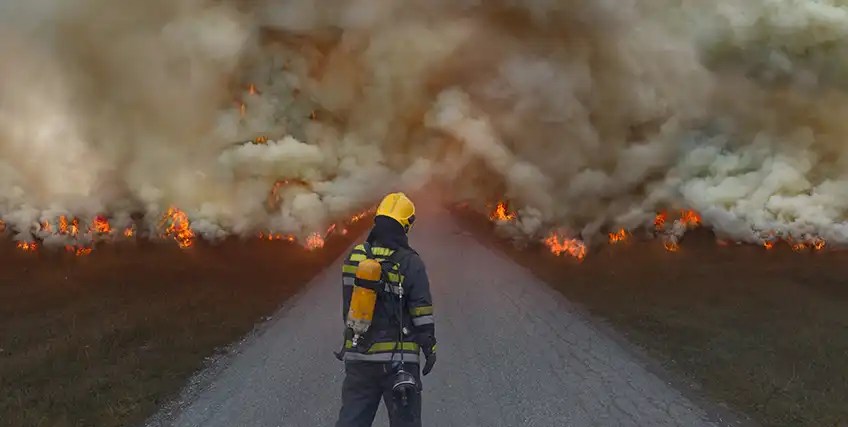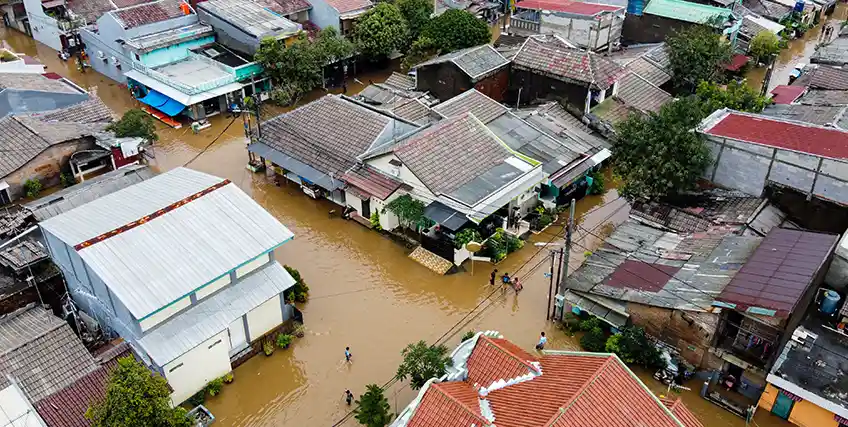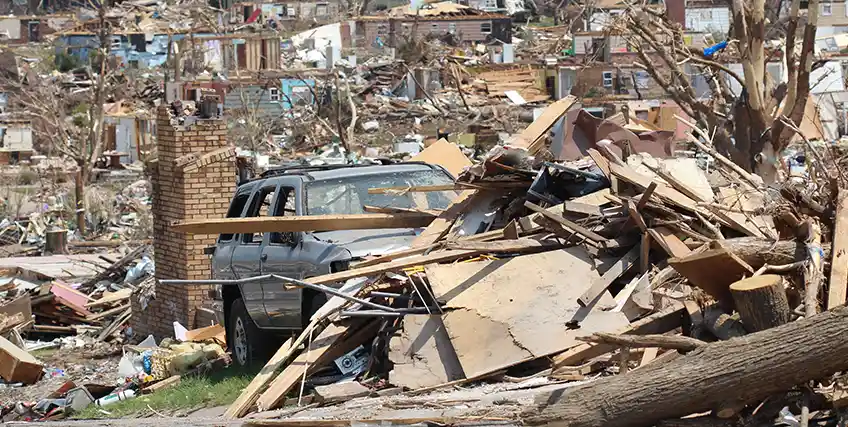How to Apply for an SBA Disaster Loan: Step-by-Step Guide: Which One to Choose in an Emergency?
July 1, 2025 | Last Updated on: July 2, 2025

According to the Federal Reserve’s Small Business Credit Survey, each year, nearly one in 10 small businesses lose money because of a natural disaster. When a wildfire, hurricane, or even civil unrest damages your business and halts its operations, the loss of revenue can be significant.
Recovering from the physical and economic damage can feel overwhelming and tedious. But, thankfully, you have the option of an SBA disaster loan application to apply for assistance and rebuild your business.
The U.S. Small Business Administration (SBA) offers special low-interest disaster loans to assist businesses recovering from major disasters in declared disaster areas. The SBA also extends these disaster loans to private non-profit organizations and homeowners.
There are different types of disaster loans, and it’s important to understand which option is right for your situation if your business has losses from a disaster. The application process can be complex. But we’re here to help.
This guide will focus on the different types of SBA disaster loans for businesses. We’ll show you the steps needed to get help when you need it most.
Understanding SBA Disaster Loans
A significant number of companies struggle after a disaster hits. In fact, 40% of businesses don’t open their doors again after a disaster; another 25% fail in the year following a disaster.
According to JP Morgan Chase, half of all small businesses only have enough cash flow to run their business for 27 days. Without new revenue in the days and weeks after a disaster, these businesses are at great risk.
The SBA Disaster Loan program was created to cover physical damage, lost revenue, and other losses not reimbursed by insurance or the Federal Emergency Management Agency (FEMA). To see if you can get approved, you’ll need to fill out an SBA disaster loan application on the SBA.gov website.
Types of SBA Disaster Loans
There are four primary types of SBA disaster loan programs for businesses.
- Business Physical Disaster Loans: This physical damage loan offers up to $2 million to repair or replace covered losses in a declared disaster area. These losses include:
- Real Property
- Equipment
- Machinery
- Inventory
- Fixtures
- Leasehold improvements
- Economic Injury Disaster Loans (EIDL): An Economic Injury Disaster Loan can help provide working capital so a business in a declared disaster area can pay its operational expenses. These expenses include:
- Rent
- Utilities
- Health care expenses
- Recurring debt payments and accounts payable
- Military Reservist Economic Injury Loans: This type of loan is for businesses with an employee who is also a military reservist called to active duty.
- SBA Mitigation Assistance: This loan was designed for businesses that want to increase protection against future disasters. Loan funds from an SBA Mitigation Loan can be used for upgrades to protect against future wind, flood, wildfire, hail, and earthquake damage.
Which SBA Disaster Loan Application is Best For Your Business - Common Scenarios to Consider
It’s essential when filing your SBA disaster loan application to apply to the right program to get relief. Choose the one that best fits your business’s situation. Review the individual pages for each loan type on the SBA website.
In the meantime, here are some common scenarios that may help you determine which SBA disaster loan application might be right for your business.
Scenario #1: Water and Wind-Damaged Restaurant
A popular restaurant in New Orleans suffered severe damage after a hurricane. Part of the roof collapsed, and the flooring, drywall, and much of the restaurant contents were damaged or destroyed. The owner applied for a Business Physical Disaster Loan to cover the costs of repairing the physical store and replacing the lost equipment, machinery, fixtures, tables, and leasehold improvements. Without the SBA disaster loan, the business would have closed down permanently.
Scenario #2: Smoke From Wildfires Forces Business Closure
A wine-tasting room in Northern California had to shut down for three weeks due to smoke from nearby wildfires. While their facility wasn’t physically damaged, customers stopped visiting due to air quality warnings. An Economic Injury Disaster Loan allowed the business to pay recurring loan obligations and utility bills during the downtime.
Scenario #3: Key Technician Called to Duty
An HVAC company in Ohio lost its lead service technician when he was called to active duty overseas. The technician managed most of the larger installations and trained junior staff. With a Military Reservist Economic Injury Loan, the company hired a temporary contractor and covered overhead expenses during the employee’s absence, avoiding contract delays and lost revenue.
Scenario #4: Upgrading Roof and Windows in Tornado-Prone Area
A childcare center in Kansas had part of its roof ripped off during a tornado, forcing the business to close its doors until repairs were made. After receiving BPDL funds for repairs, they used SBA mitigation assistance funding to install reinforced roofing, storm-resistant windows, and a new emergency generator to prevent future extended closures.
Meeting Eligibility for an SBA Gov Disaster Loan Application
The exact requirements for SBA disaster loans differ from one SBA loan type to another. However, most require your business to be in a declared disaster area. Each loan outlines specific conditions for funding and requires the borrower to meet certain requirements for how the funds can be used.
For example, disaster loan funds can’t be used to upgrade or expand a business. However, in some situations, the funds can be used to make upgrades to protect against future losses from a disaster.
Disaster loans over $50,000 also require collateral. Most programs defer the first payment and don’t accrue interest for the first 12 months. The EIDL and Military Reservist loan programs are capped at 4% interest. The Business Physical Disaster Loan program caps interest at 4% for borrowers who can’t get credit approval elsewhere and 8% for borrowers who qualify for financing with another provider.
Go to the SBA website to learn more about each loan, its requirements and conditions, and general repayment terms.
Steps to Take When Filling Out an SBA Disaster Loan Application
It’s vital to know which steps are needed before applying for an SBA disaster loan. This will help you understand the process and complete each step in order so that your application isn’t delayed.
1. Confirm Disaster Declaration and Eligibility Before Submitting an SBA Disaster Loan Application
Before applying for disaster assistance and filling out an SBA disaster loan application, you must verify that your business is located in an area that qualifies for aid. Here’s how to do it:
- Visit the FEMA Disaster Declarations page or the SBA Disaster Loan Assistance site (many people find these sites simply by googling things like “disaster loan SBA gov application”).
- Search by state, county, or disaster number to confirm if your location is included in a current disaster declaration.
- Ensure the declaration specifically covers the type of assistance you need.
Note the filing deadline and get your SBA disaster loan application in before then.
2. Gather the Documents Required For an SBA Disaster Loan Application
It’s best to have your loan application documents on hand before filing for your loan. That way, you won’t miss anything and delay your application. The list of documents that are usually required for an SBA disaster loan application includes:
- Tax returns
- Financial statements such as a profit & loss statement and balance sheet
- Business ownership documents
- Insurance information
- Schedule of liabilities listing your business’s current debts and obligations
You’ll also need to list the basic information on the SBA form about your business, such as its legal name, address, contact information, the date your business started, and your employer identification number (EIN) or social security number.
3. Fill Out Your SBA Disaster Loan Application to Request Financial Relief for Your Disaster Loan
Visit the SBA’s disaster assistance homepage and look for the red button that states, “Apply for Disaster Loans.” You’ll also be prompted to create an account.
The SBA Disaster Loan application portal is very user-friendly and divided into sections. Here are some tips to keep in mind when applying:
- Choose the right type of loan for your needs, and be sure you meet eligibility requirements for the loan.
- Take your time and fill in all required fields. Make sure everything is correct.
- Double-check all numbers, including your EIN, financial figures, and dates. Avoid estimates and be as accurate as possible when it comes to financial calculations.
- Upload any correct documents in the requested format (such as PDF documents). Also, ensure that all uploaded documents are legible.
- Once your SBA disaster loan application is complete, submit it on the portal. Submit your application as early as possible because funds are often limited and come on a first-served basis.
4. Monitor Your SBA Disaster Loan Application Status
After you’ve submitted your SBA disaster loan application, watch for a confirmation email and an application number.
- Look for future emails requesting any additional documentation. Respond quickly to any requests.
- Monitor the status of your application on the SBA’s official website. The SBA should start reviewing your application within a few days.
- Allow two to three weeks for a decision. If much more time than that has passed since you submitted your application, contact the SBA for an update.
5. Accept the Loan Terms After Approval
If your SBA disaster loan is approved, you’ll receive a loan agreement detailing the loan amount, interest rate, prepayment terms, and an outline of how you can use the funds.
- Review the agreement in full before signing.
- If additional financials are requested, submit them promptly to avoid a delay in funding.
- Watch for your first loan disbursement (usually no more than a week later). Depending on the loan amount, your business needs, and the type of loan, you may receive your loan funds in multiple disbursements.
Things to Keep in Mind After You Receive Funding
Remember to adhere to the SBA’s rules about how you can use your disaster loan funds. Anything viewed as a violation of your loan terms can result in fines or even the revocation of your loan funds.
Depending on the loan type, most disaster loans can only be used for working capital, payroll and operating expenses, fixed debts, and physical repairs.
Here are some other things to consider:
- Make copies or screenshots of your complete SBA disaster loan application.
- Keep detailed records of how you use the funds. Keep all receipts and copies of bank statements proving how you’ve spent the loan.
- Stay audit-ready in case the SBA decides to audit your funds. Keep all records for at least three years.
- Be sure to get and keep invoices and receipts from contractors involved in the rebuilding process.
FAQs About SBA Disaster Loan Applications
1. What type of credit score do I need to qualify for an SBA disaster Loan?
It’s possible to get an SBA disaster loan with a lower credit score in the high 500s if you aren’t applying for a significant amount. But a higher loan amount will require a credit score in the high 600s, along with more collateral.
2. Can anything disqualify my business from an SBA GOV disaster loan?
Yes. Common reasons for disqualification include insurance or FEMA funding covering your damages, living outside a declared disaster zone, submitting incomplete or inaccurate information on your application, and being unable to repay the loan. A prior default on government debt or having a business in a risky industry can also exclude you from getting a disaster loan.
3. What are the repayment terms if my SBA disaster loan application is approved?
The SBA will loan up to $2 million for small businesses with average interest rates just under 4%. Interest on the loan doesn’t accumulate until 12 months after receiving your loan funds. You will typically have up to 30 years to repay a business disaster loan from the SBA, and the first payment isn’t due until 12 months after the loan funds have been disbursed.
4. What is the approval rate for SBA disaster loan applications?
A report by the U.S. Government Accountability Office found that 42% of all SBA disaster loan applications were approved from 2018 to 2022. This includes applications by homeowners, renters, and businesses. The most common reasons for rejections were unsatisfactory credit, inability to repay the loan, and failure of a property or business to meet eligibility requirements.
5. What are my options if my EIDL loan application isn’t approved?
If your EIDL application is rejected, you can appeal the decision. Next, you can check with your local Small Business Development Center to see if there is a local or state relief program. You can also look into a non-disaster SBA loan or apply for a small business loan with an alternative lender. You may be able to refinance current debt or get revenue-based financing.
Navigating business financing, whether for disaster loans or a standard small business loan, is easier with the help of a funding specialist.
Frequent searches leading to this page
Related Articles
How to Apply for an SBA Disaster Loan: Step-by-Step Guide: Which One to Choose in an Emergency?
July 2, 2025




